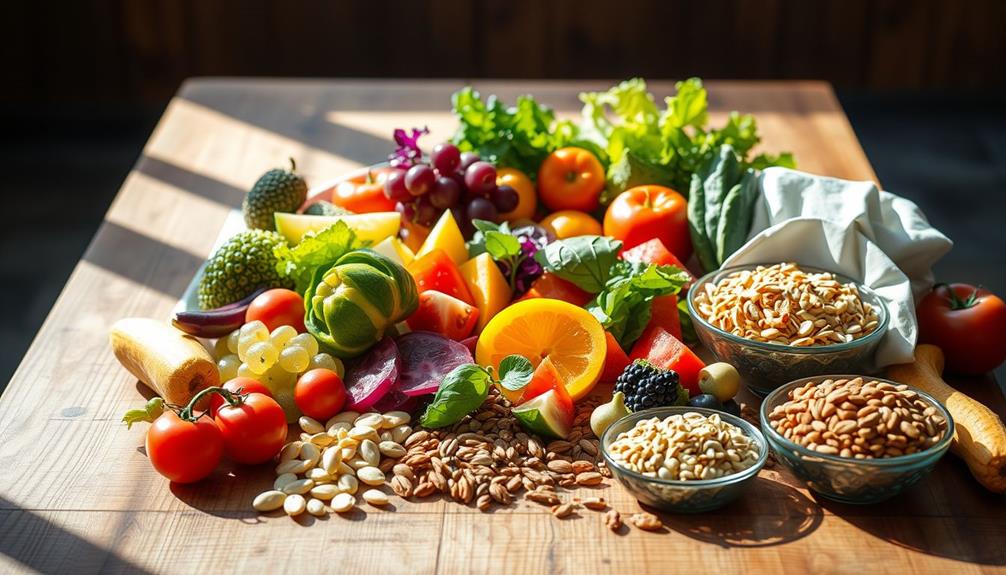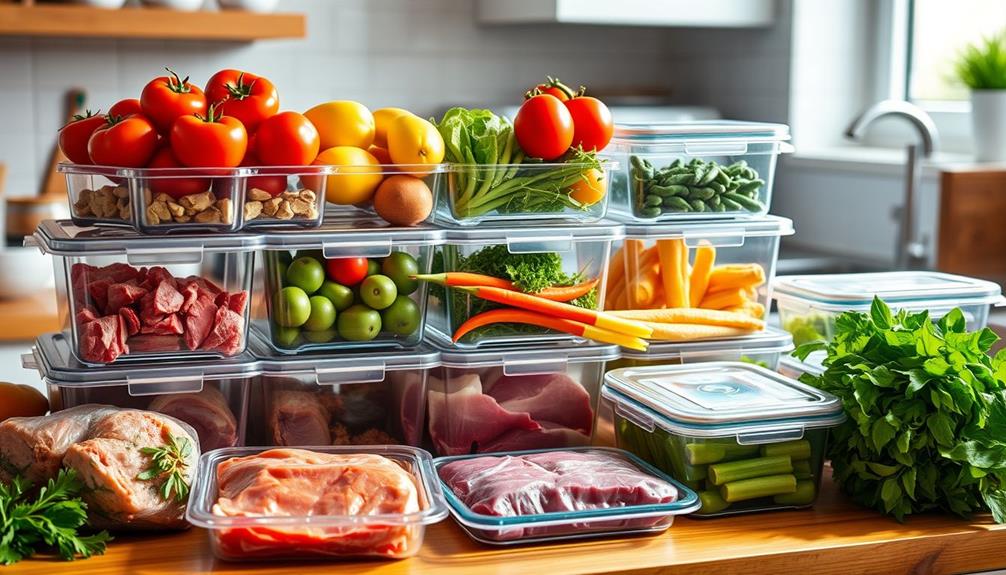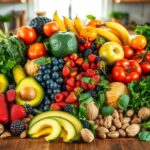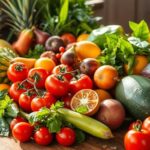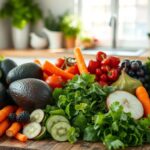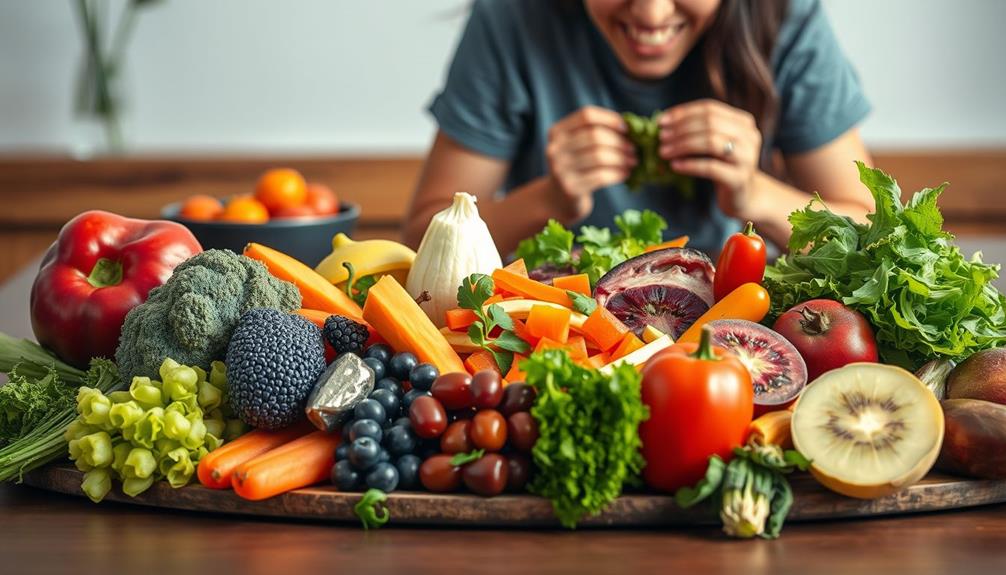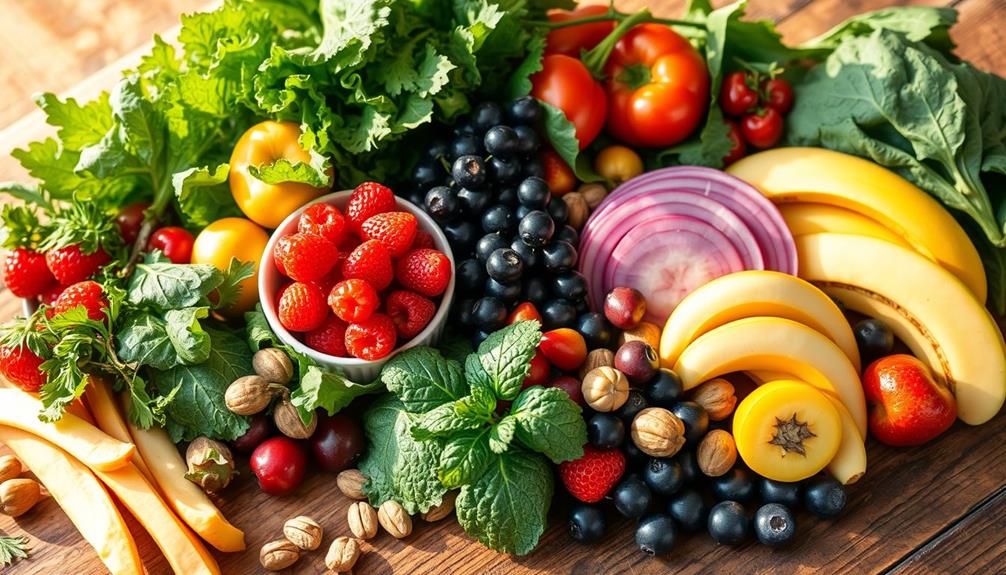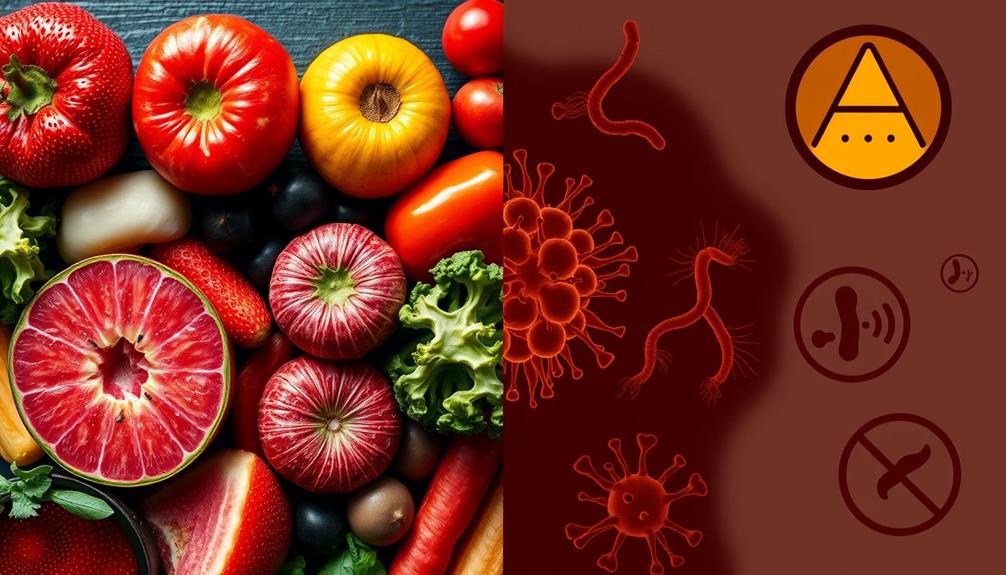Eating a raw food diet means diving into unprocessed, uncooked foods like fruits, vegetables, nuts, and seeds. Start by incorporating one raw meal each day, maybe a delicious smoothie or a vibrant salad. Use tools like a blender and food processor to make prep easier. Focus on soaking nuts and sprouting grains for better digestibility. Pay attention to nutrient balance to avoid deficiencies. Join online communities for support and recipe ideas. With the right approach, you'll enjoy the health benefits of increased energy and improved digestion. Keep going, and you'll discover more tips and tricks for a tasty raw food journey! For more success with your raw food diet, consider investing in a dehydrator to create tasty raw snacks like kale chips or fruit leather. Experiment with different flavor combinations and seasoning options to keep things interesting. Remember to stay hydrated and listen to your body’s needs as you navigate your raw food journey. And don’t forget to check out some raw food diet tips for meal planning and shopping strategies to make the transition even smoother.
Key Takeaways
- Focus on unprocessed, uncooked foods like fruits, vegetables, nuts, seeds, and sprouted grains while avoiding heat above 104-118°F (40-48°C).
- Equip your kitchen with essential tools such as a blender, food processor, dehydrator, and spiralizer to prepare raw meals.
- Start with simple meal ideas like smoothies, salads, and raw soups to ease into the raw food diet.
- Gradually incorporate raw foods, beginning with one raw meal per day, to help your body adjust.
- Join online communities or local groups for support, recipe ideas, and motivation on your raw food journey.
Understanding Raw Food Diet
Understanding the raw food diet means embracing a lifestyle centered around unprocessed and uncooked foods. This diet primarily focuses on raw fruits, vegetables, nuts, seeds, and sprouted grains. You'll typically avoid any foods heated above 104-118°F (40-48°C) to preserve crucial nutrients and enzymes. By doing so, you enhance your body's ability to digest food more efficiently while enjoying an array of flavors and textures.
Following a raw food diet can also boost your immune system due to the high vitamin and antioxidant levels found in these foods.
Common preparation methods include juicing, blending, soaking, sprouting, and dehydrating. These techniques help retain nutritional value and keep your meals exciting. While raw food diets are primarily plant-based, some variations allow for raw animal products like eggs, dairy, fish, or meat, giving you flexibility based on your dietary preferences.
Transitioning to a raw food diet requires mindfulness about maintaining nutritional balance. It's important to confirm you're getting a wide range of nutrients to support your health. By steering clear of processed foods and focusing on whole, raw options, you set yourself up for potential health benefits like increased energy, better skin health, and reduced risk of chronic diseases.
Embrace this journey, and discover the vibrant world of raw eating!
Health Benefits of Raw Foods
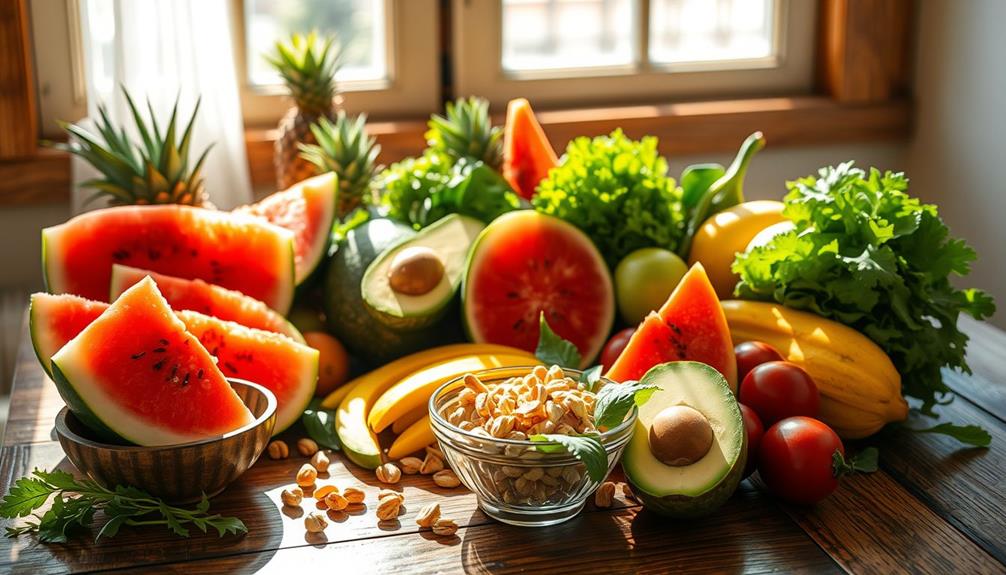
When you embrace a raw food diet, you're tapping into a wealth of nutrient-dense options that can supercharge your health.
This approach supports digestive health and can aid in weight management, helping you feel full while consuming fewer calories.
Raw foods, such as celery juice, are known for their anti-inflammatory properties and hydration benefits.
Nutrient Density Advantages
Have you ever wondered why many health enthusiasts swear by a raw food diet? The nutrient density advantages of raw foods play a significant role in this. Raw fruits and vegetables are packed with essential vitamins, minerals, and antioxidants that support your overall health. For example, when consumed raw, fruits can have higher vitamin C levels compared to their cooked counterparts.
Here's a quick comparison of some benefits:
| Nutrient | Benefit |
|---|---|
| Vitamins & Minerals | Higher levels in raw foods |
| Fiber | Aids digestion and promotes gut health |
| Enzymes | Enhance nutrient absorption |
| Antioxidants | Combat oxidative stress |
With a raw food diet, you also benefit from the high fiber content, which can reduce the risk of chronic diseases like heart disease and diabetes. The presence of enzymes in raw foods enhances nutrient absorption, making your diet healthy. Additionally, the high water content in fruits and vegetables can lead to lower calorie intake, supporting weight management and fat loss. Embracing raw foods can truly elevate your health journey.
Digestive Health Support
A raw food diet can be a game-changer for your digestive health. By incorporating raw foods into your meals, you're boosting your fiber intake, which promotes healthy digestion and regular bowel movements. This can greatly reduce your risk of constipation and other digestive disorders.
Additionally, the key domains of development in psychology highlight how environmental factors can shape our health habits, including dietary choices.
The enzymes found in raw fruits and vegetables are fundamental for breaking down food, enhancing nutrient absorption, and improving overall digestive efficiency. Eating a diverse range of raw foods, especially leafy greens and fresh fruits, can help maintain a balanced gut microbiome, essential for optimal digestive health.
Moreover, many raw foods have high water content, keeping your digestive system hydrated, which is crucial for healthy digestion and preventing gastrointestinal issues.
The abundance of antioxidants and anti-inflammatory compounds present in fresh produce may also reduce the risk of inflammatory digestive conditions.
Weight Management Potential
The raw food diet's weight management potential is impressive, offering a practical approach to maintaining a healthy body. By focusing on eating raw foods, you can greatly impact your overall health and weight management goals.
Here are some benefits of adopting raw foodism for weight control:
- Low in calories while high in fiber, promoting fullness.
- Notable reductions in body fat and waist circumference.
- High water content aids in hydration and appetite regulation.
- Antioxidants combat inflammation and boost metabolism.
Additionally, a raw food diet can help reduce cravings for high-calorie snacks, similar to the benefits of natural remedies alongside conventional medications.
When you consume a diet rich in raw fruits and vegetables, you naturally limit your calorie intake without feeling deprived. This helps reduce cravings for high-calorie, processed snacks, making it easier to stay on track with your weight management efforts.
Research has shown that individuals on a raw food diet often experience noticeable changes in their body composition, contributing to a healthier lifestyle overall.
Incorporating raw foods into your daily meals can create a satisfying and nutritious way to achieve your weight goals.
Getting Started on Raw Foods
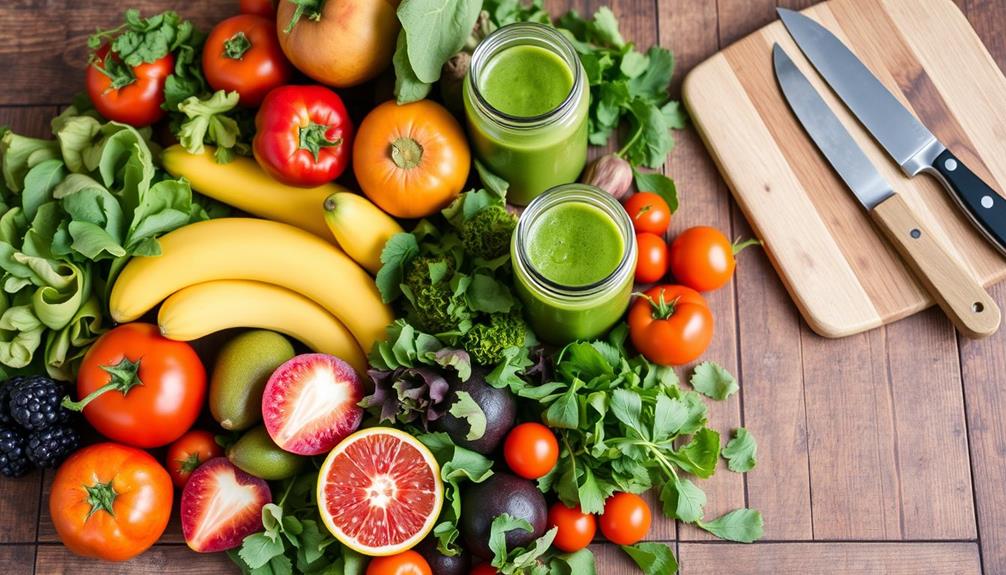
Getting started on a raw food diet can be exciting but may come with some challenges.
You'll want to equip your kitchen with essential tools and explore simple meal ideas to make the shift smoother.
Incorporating herbal teas like chamomile or ginger can also be beneficial, as they may help alleviate stress during this dietary change herbal teas for relaxation.
Don't hesitate to seek support from communities or friends to help you stay motivated along the way.
Essential Tools Needed
Starting your raw food journey requires some essential tools that can make meal prep easier and more enjoyable. Investing in the right equipment will help you create delicious meals and maintain your new lifestyle.
For instance, exploring different brewing methods can inspire creativity in your raw food recipes. Here are four must-have tools to get you started:
- Blender: A high-quality blender is vital for whipping up smoothies, soups, and sauces. It'll allow you to easily blend raw fruits, vegetables, and nuts into tasty creations.
- Food Processor: This handy appliance is perfect for chopping, slicing, and grating various raw ingredients, making your meal prep quicker and more efficient.
- Dehydrator: A dehydrator is ideal for creating raw snacks like fruit leathers, veggie chips, and sprouted grain crackers. It removes moisture while preserving essential nutrients.
- Spiralizer: A spiralizer transforms vegetables like zucchini and carrots into noodle-like shapes, adding a fun twist to your raw meals.
Additionally, don't forget to invest in glass storage containers to keep your prepped ingredients fresh and organized.
With these essential tools, you'll be well on your way to enjoying a vibrant raw food diet!
Simple Meal Ideas
With the right tools in hand, you'll find it easy to whip up simple and delicious meals that align with your raw food lifestyle. Eating raw, plant-based foods can be both satisfying and energizing. Here are some meal ideas to get you started:
| Meal | Ingredients | Preparation |
|---|---|---|
| Breakfast | Spinach, banana, almond milk | Blend into a revitalizing smoothie |
| Lunch | Bell peppers, cherry tomatoes, cucumbers | Toss with lemon and olive oil |
| Dinner | Zucchini (spiralized), tomatoes, garlic, basil | Blend into a raw marinara sauce |
For a quick snack, munch on raw fruits like apples or berries, which are packed with vitamins and fiber. They'll help keep you satiated between meals. To finish your day on a sweet note, enjoy raw cacao energy balls made from dates, nuts, and cacao powder. These treats are not only delicious but also a healthy dessert option. Incorporating these simple meal ideas will make your shift to a raw food diet enjoyable and nourishing!
Overcoming Initial Challenges
Shifting to a raw food diet can be a rewarding experience, but it often comes with its own set of challenges. As you're getting started, here are some tips for overcoming initial challenges:
- Gradually incorporate raw foods, starting with one raw meal per day. Adding fresh ingredients can enhance your meals, much like how essential oils for respiratory health can support overall wellness.
- Experiment with simple recipes like smoothies or salads to keep meal prep enjoyable.
- Source seasonal and local produce to enhance flavor and nutrition.
- Join online communities or local groups for support and motivation.
As a new raw foodist, you might face digestive discomfort during the adjustment phase. This is normal, so be mindful of how your body reacts.
To ease the change, consider increasing your water intake and fiber gradually to support your digestive system.
This diet provides numerous health benefits, but patience is key. Remember that everyone's journey is unique, and it's okay to take your time.
By gradually integrating raw foods into your meals and seeking support from fellow raw foodists, you can make the process smoother and more enjoyable.
Embrace the journey, and soon enough, you'll find yourself thriving on a vibrant raw food diet!
Meal Preparation Techniques
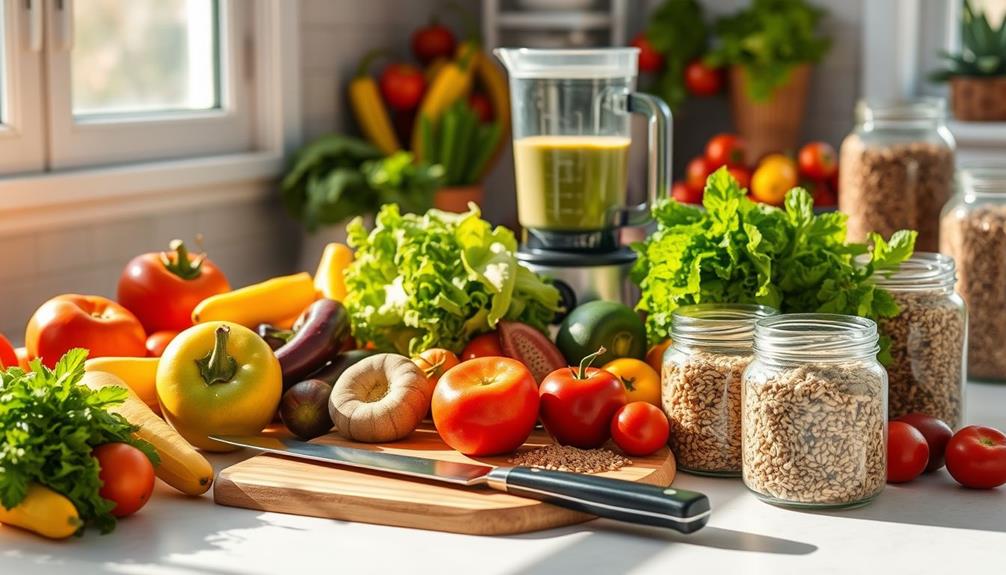
When preparing meals for a raw food diet, it's essential to utilize techniques that enhance both flavor and nutrition. One effective method is soaking nuts and seeds. By soaking them for several hours, you improve their digestibility, nutrient absorption, and reduce enzyme inhibitors. This simple step can make a significant difference in your meals.
Additionally, using well-draining soil for your indoor plants can help create a vibrant environment that complements your healthy lifestyle.
Another valuable technique is sprouting grains and legumes. Sprouting boosts their nutritional value and enriches them with vitamins and enzymes, making them easier to digest. Incorporating sprouted ingredients can elevate your raw dishes.
Blending fruits and vegetables into smoothies is also a game-changer. This technique helps retain fiber while allowing you to consume larger quantities of produce, maximizing your nutrient intake. Plus, smoothies can be a delicious way to experiment with different flavor combinations.
For snacks, consider dehydrating fruits and vegetables at low temperatures. This preserves nutrients while intensifying flavors, creating portable and tasty options.
Common Challenges Faced

Starting a raw food diet can be exciting, but it also comes with its share of challenges. As you commence on this journey, be prepared to face some common hurdles that can impact your experience.
One major challenge is the potential for nutrient deficiencies if your diet isn't well-balanced, especially important considering the need for proper financial planning for assisted living. You'll need to plan meals carefully to avoid lacking essential nutrients.
Additionally, as your body adjusts to higher fiber levels, you might experience digestive discomfort at first.
Social situations can be tricky, too, as you may find limited raw options at restaurants or gatherings.
Don't forget about cravings—it's common to miss cooked foods, so having strategies in place will help you cope.
Resources and Support Networks

Finding the right resources and support networks can greatly enhance your raw food diet experience. Joining online communities and forums dedicated to raw food diets is an excellent way to connect with like-minded individuals, fostering emotional resilience as you navigate lifestyle changes. Here, you'll gain access to invaluable support, recipe ideas, and encouragement, while exploring the power of imagination to reshape your dietary habits.
Social media platforms like Instagram and Facebook also host numerous groups where raw food enthusiasts share tips and meal inspirations.
Additionally, consider attending local raw food meetups or workshops. These gatherings not only foster connections with others pursuing similar dietary goals but also provide hands-on learning opportunities to deepen your understanding of the diet.
For more structured guidance, websites like The Raw Food World and Raw Food Recipe offer extensive resources, including recipes, articles, and product recommendations tailored for beginners.
Connecting with health professionals, such as nutritionists or dietitians who specialize in raw food diets, can provide personalized guidance, ensuring your nutritional needs are met.
Frequently Asked Questions
How to Start a Raw Food Diet?
To start a raw food diet, begin by adding one raw meal daily. Gradually increase your intake, focusing on colorful fruits and veggies. Invest in good kitchen tools, and explore various preparation methods for enhanced flavors.
What Foods Can You Eat on a Raw Food Diet?
Did you know that a raw food diet can boost your energy levels by up to 30%? You can enjoy fresh fruits, veggies, nuts, seeds, and sprouted grains, all packed with nutrients for vibrant health.
What Are 10 Raw Foods?
You can enjoy a variety of raw foods, including apples, spinach, almonds, cucumbers, blueberries, carrots, kale, walnuts, bell peppers, and sprouted quinoa. These options provide essential nutrients while keeping your meals fresh and delicious.
What Is the Raw Food Diet Method?
Imagine a garden where vibrant fruits and vegetables thrive untouched by heat. In the raw food diet, you embrace nature's bounty, consuming whole, unprocessed foods to boost energy, enhance digestion, and nourish your body.
Conclusion
Embracing a raw food diet can feel like stepping into a vibrant, uncharted garden, ripe with possibilities. As you explore this fresh culinary landscape, remember that each meal is a chance to nurture your body and spirit. While challenges may arise, like shadows in a sunlit grove, don't hesitate to lean on the resources and communities around you. With each bite, you're not just eating; you're initiating a transformative journey toward health and liveliness.

